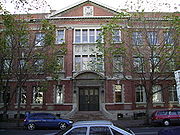
University of Otago Dunedin School of Medicine
Encyclopedia

Medical school
A medical school is a tertiary educational institution—or part of such an institution—that teaches medicine. Degree programs offered at medical schools often include Doctor of Osteopathic Medicine, Bachelor/Doctor of Medicine, Doctor of Philosophy, master's degree, or other post-secondary...
s that make up the Faculty of Medicine at the University of Otago
University of Otago
The University of Otago in Dunedin is New Zealand's oldest university with over 22,000 students enrolled during 2010.The university has New Zealand's highest average research quality and in New Zealand is second only to the University of Auckland in the number of A rated academic researchers it...
. All Otago University medical students who gain entry after a first year "Health Sciences" program, or who gain graduate entry spend their second and third years studying in Dunedin at the school of medicine. In their fourth and fifth years, medical students can either continue to study in Dunedin, or at the Christchurch
University of Otago Christchurch School of Medicine
The University of Otago, Christchurch, formerly Christchurch School of Medicine and Health Sciences, in Christchurch, New Zealand, is one of three medical schools that make up the Faculty of Medicine at the University of Otago. It is based primarily at Christchurch Hospital, in Christchurch Central...
or Wellington Schools of Medicine
University of Otago Wellington School of Medicine
The Wellington School of Medicine and Health Sciences is one of three medical schools that make up the Faculty of Medicine at the University of Otago. All Otago University medical students who gain entry after a first year "Health Sciences" program, or who gain graduate entry spend their second and...
.
History
Opened in 1875, the Otago Medical School (as it was then known) initially taught a 2 year course with training completed overseas. 1887 saw the first medical graduate taught solely at Otago, and in 1891 the medical school was formally made the Faculty of Medicine. Until 1920, training took only four years, but was then extended to six.From 1924, students could complete their last year of training at hospitals in either Auckland
Auckland
The Auckland metropolitan area , in the North Island of New Zealand, is the largest and most populous urban area in the country with residents, percent of the country's population. Auckland also has the largest Polynesian population of any city in the world...
, Christchurch
Christchurch
Christchurch is the largest city in the South Island of New Zealand, and the country's second-largest urban area after Auckland. It lies one third of the way down the South Island's east coast, just north of Banks Peninsula which itself, since 2006, lies within the formal limits of...
, or Wellington
Wellington
Wellington is the capital city and third most populous urban area of New Zealand, although it is likely to have surpassed Christchurch due to the exodus following the Canterbury Earthquake. It is at the southwestern tip of the North Island, between Cook Strait and the Rimutaka Range...
as well as Dunedin
Dunedin
Dunedin is the second-largest city in the South Island of New Zealand, and the principal city of the Otago Region. It is considered to be one of the four main urban centres of New Zealand for historic, cultural, and geographic reasons. Dunedin was the largest city by territorial land area until...
. In 1938, branch faculties were established in these other centres. Otago's relationship with Auckland ceased after the opening of the University of Auckland's School of Medicine
University of Auckland, Faculty of Medical and Health Sciences
The University of Auckland's Faculty of Medical and Health Sciences was established in 1968 at its present site in Grafton, Auckland...
in 1968. The branch faculties in Christchurch and Wellington became 'clinical' schools in 1973 and 1977 respectively, the forerunners to the modern Christchurch and Wellington Medical Schools.

